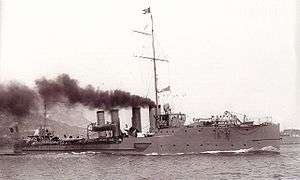Bouclier-class destroyer
 Bouclier, lead ship of the series, circa 1914 | |
| Class overview | |
|---|---|
| Name: | Bouclier class |
| Operators: |
|
| Preceded by: | Chasseur class |
| Succeeded by: | Bisson class |
| Built: | 1909–13 |
| In commission: | 1911–33 |
| Completed: | 12 |
| Lost: | 4 |
| Scrapped: | 8 |
| General characteristics | |
| Type: | Destroyer |
| Displacement: | 732–809 t (720–796 long tons) |
| Length: | 72.3–78.3 m (237 ft 2 in–256 ft 11 in) (o/a) |
| Beam: | 7.6–8 m (24 ft 11 in–26 ft 3 in) |
| Draft: | 2.9–3.3 m (9 ft 6 in–10 ft 10 in) |
| Installed power: |
|
| Propulsion: | 2–3 shafts; 2–3 Steam turbines |
| Speed: | 30 knots (56 km/h; 35 mph) |
| Range: | 1,200–1,600 nmi (2,200–3,000 km; 1,400–1,800 mi) at 12–14 knots (22–26 km/h; 14–16 mph) |
| Complement: | 80–83 |
| Armament: |
|
The Bouclier class, or Casque class, was a class of twelve destroyers of the French Navy built between 1910 and 1912, four of which were lost during the First World War.
This 800-tonne class were built by various shipyards to a general specification that included oil-fired boilers and steam turbines. This allowed for some variations in size (from 237–256 ft (72–78 m) in length) and machinery (Bouclier and Casque had three shafts, all the others had two, while Casque has three funnels, all the rest had four). Speeds also varied, Bory was the slowest at only 24 knots (44 km/h; 28 mph), while Bouclier achieved 35.5 knots (65.7 km/h; 40.9 mph) in trials.[1]
All ships of the class received the standard armament of two 100 mm (3.9 in) 1893 Model guns, four 65 mm (2.6 in) 1902 Model guns and two twin trainable 450 mm (18 in) torpedo tubes. During World War I, a 45 mm (1.8 in) or 75 mm (3 in) anti-aircraft gun, two 8 mm (0.31 in) machine guns, and eight or ten Guiraud-type depth charges were added.[1]
All but three (Bouclier, Capitaine Mehl and Francis Garnier) of the ships in the class served in the Mediterranean Sea between 1914 and 1918.[1]
Ships
| Name | Builder | Launched | Fate |
|---|---|---|---|
| Bouclier | Chantiers et Ateliers Augustin Normand, Le Havre | 29 June 1911 | Struck, 15 February 1933 |
| Boutefeu | Dyle et Bacalan, Bordeaux | 2 May 1911 | Sunk by mine laid by UC-25 off Brindisi, 15 May 1917, during the Battle of the Strait of Otranto |
| Capitaine Mehl | Ateliers et Chantiers de la Loire, St. Nazaire | 20 April 1912 | Struck, 10 July 1926 |
| Casque | Forges et Chantiers de la Méditerranée, Le Havre | 25 August 1910 | Struck, 26 March 1926. Broken up, 1927. |
| Cimeterre | Forges et Chantiers de la Gironde, Bordeaux | 13 April 1911 | Struck, 10 July 1926 |
| Commandant Bory | Dyle et Bacalan, Bordeaux | 14 September 1912 | Struck, 29 July 1926 |
| Commandant Rivière | Forges et Chantiers de la Gironde, Bordeaux | 2 October 1912 | Struck, June 1933 |
| Dague | 13 April 1911 | Sunk by a drifting mine in Antivari Roads, 24 February 1915 | |
| Dehorter | Ateliers et Chantiers de Penhoët, Saint-Nazaire | 18 April 1912 | Struck, 1933 |
| Faulx | Établissement de la Brosse et Fouché, Nantes | 2 February 1911 | Accidentally rammed and sunk by Mangini in Strait of Otranto, 18 April 1918 |
| Fourche | 21 October 1910 | Torpedoed and sunk by U-15, 23 June 1916 | |
| Francis Garnier | Chantiers et Ateliers Augustin Normand, Le Havre | 1 October 1912 | Struck, 10 February 1926 |
Citations
- 1 2 3 "Conway's All the World's Fighting Ships, 1906-1921". books.google.co.uk. Retrieved 1 July 2010.
Bibliography
- "BOUCLIER - Contre-torpilleur - marine - Forum Pages d'Histoire: marine". pages14-18.mesdiscussions.net. Retrieved 25 October 2015.
- Couhat, Jean Labayle (1974). French Warships of World War I. London: Ian Allen. ISBN 0-7110-0445-5.
- Gardiner, Robert & Gray, Randal (1985). Conway's All The World's Fighting Ships 1906–1921. London: Conway Maritime Press. ISBN 0-85177-245-5.
- Osborne, Eric W. (2005). Destroyers - An Illustrated History of Their Impact. Santa Barbara, California: ABC-Clio. ISBN 1-85109-479-2.
- Roche, Jean-Michel (2005). "Classement par types". Dictionnaire des bâtiments de la flotte de guerre française de Colbert à nos jours 2, 1870 - 2006. Toulon: Roche. ISBN 978-2-9525917-0-6. OCLC 165892922.
External links
| Wikimedia Commons has media related to Bouclier-class destroyer. |